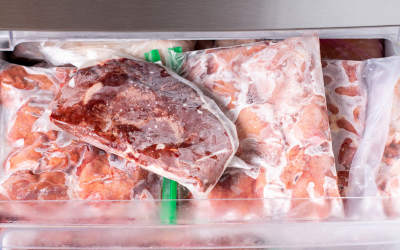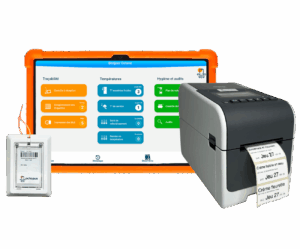Defrosting in foodservice
This article outlines best practices for thawing food in collective catering and highlights tools to ensure operational safety: HACCP training, free downloadable guides, and the Octopus HACCP digital application.
Key Rules for Thawing in Collective Catering
Compliance with HACCP Temperature Guidelines
HACCP temperature standards for food must be strictly followed, as each range poses varying risks for bacterial growth:
- Between +63°C and +3°C: The “danger zone” where pathogenic bacteria multiply rapidly.
- Between +3°C and -18°C: Bacterial growth is halted.
- Below -18°C: Bacteria become dormant.
While these thresholds apply to rapid cooling (where time/temperature control is critical), they are equally vital during thawing in collective catering.
Frozen food storage temperatures:
- -18°C: Frozen minced meat and meat preparations;
- -18°C: Frozen seafood;
- -18°C: Ice cream;
- -12°C: Other frozen foods.
Thawing in collective catering involves transitioning food from frozen temperatures to 0-3°C. A precise protocol—documented in your SCP (Sanitary Control Plan)—must be followed to prevent bacterial growth and ensure food safety.
Thawing Procedures in Collective Catering
Approved Thawing Methods
Three methods are permitted, depending on the product and its subsequent use:
- In a refrigerated unit (0-3°C);
- By cooking (direct from frozen);
- By microwave thawing (with immediate use).
Thawed foods may be stored up to 3 days at 0-3°C, except when microwaved (must be used immediately).
Some operations use controlled thawing during transport (e.g., central kitchens shipping partially thawed goods to satellite locations).
Never thaw at room temperature, in hot water, or refreeze thawed products.
All items must be properly labeled and maintained at 0-3°C during transport/storage. For such protocols, ANSES recommends limiting secondary shelf life to 24 hours.
Refrigerated Storage Guidelines During Thawing
Products must be covered (plastic wrap/lid), elevated on racks to avoid contact with thawing liquids, and handled per your HACCP cleaning protocol.
HACCP Labeling and Traceability for Thawed Foods
Thawed foods require full HACCP traceability. Documentation is essential for health inspections and potential outbreak investigations.
Due to short secondary shelf lives, labels must display thawing start dates/times.
 Streamline thawing traceability with Octopus HACCP’s labeling system. Digitize your workflow to track food from receipt to plate across satellite locations. The Octopus HACCP app ensures full traceability and enables rapid response to foodborne incidents per your SCP protocols.
Streamline thawing traceability with Octopus HACCP’s labeling system. Digitize your workflow to track food from receipt to plate across satellite locations. The Octopus HACCP app ensures full traceability and enables rapid response to foodborne incidents per your SCP protocols.



